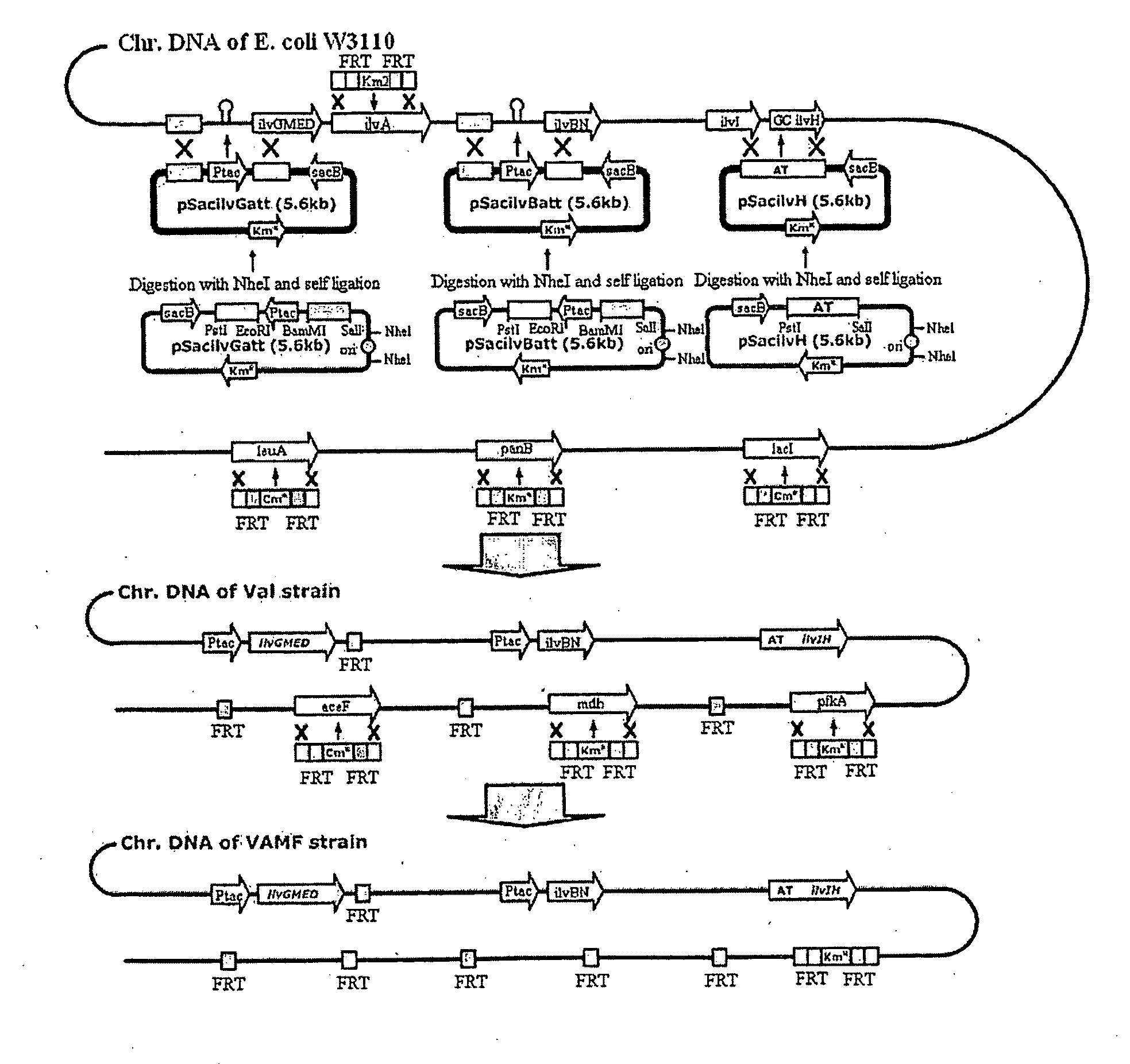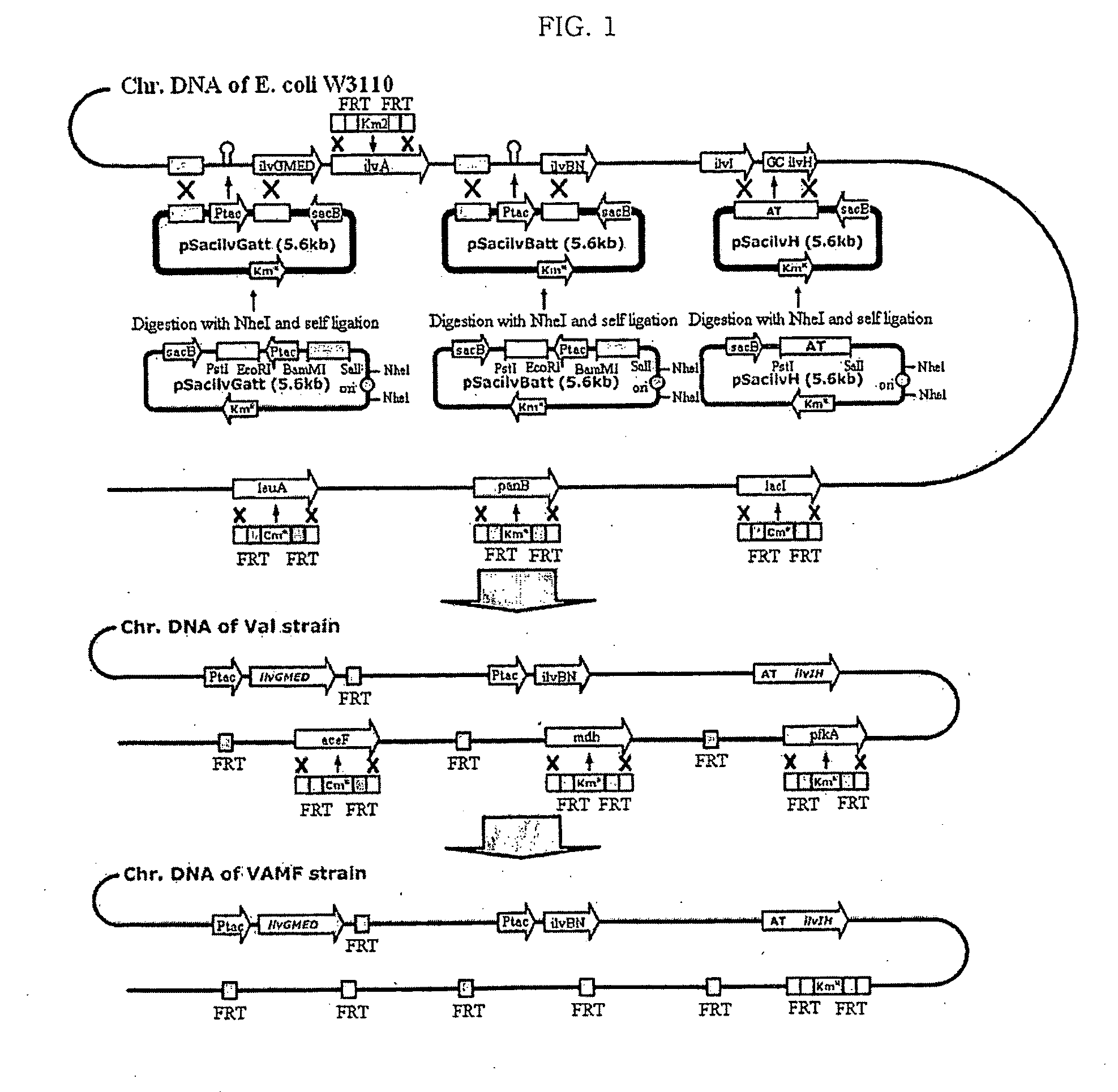Mutant microorganism having improved production ability of branched amino acid and method for preparing branched amino acid using the same
a technology of branched amino acids and mutant microorganisms, which is applied in the direction of transferases, lighting and heating apparatus, heating types, etc., can solve the problems of difficult to understand and additionally improve strains, and achieve the effect of high productivity of l-valin
- Summary
- Abstract
- Description
- Claims
- Application Information
AI Technical Summary
Benefits of technology
Problems solved by technology
Method used
Image
Examples
example 1
Construction of Mutant Microorganisms Having High Productivity of L-Valine and Measurement of L-Valine Productivity
1-1: Construction of Microorganisms Having High Productivity of L-Valine
[0054]1-1-1: Construction of pSacHR06
[0055]To substitute the specific base or bases of chromosomal DNA, pSacHR06 was constructed for the homologous recombination of Bacillus subtilis-derived sacB (Wohlleben et al., J. Bacteriol., 174:5462, 1992) (see FIG. 3). FIG. 3 shows a process of constructing the pSacHR06 vector.
[0056]For this purpose, in order to substitute the ampicillin resistance gene of a pUC19 vector (New England Biolab) with kanamycin resistance thereof, a 1.5 kb fragment obtained by digesting the pUC19 vector with NdeI and AhdI was ligated with a 1.3 kb fragment obtained by digesting a pACYC177 vector (New England Biolabs) with StuI, thus obtaining a pUC19KM vector.
[0057]Then, a 2.5 kb fragment obtained by digesting the pUC19KM vector with PvuII was ligated with a 400 bp fragment obtain...
example 2
Screening of Genes to be Deleted, by In Silico Simulation
[0072]In order to further increase the L-valine productivity of the L-valine-producing microorganisms (Val+pKBRilvBNCED) constructed in Example 1-1, genes to be deleted in order to optimize metabolic flux for L-valine production were screened using the in silico simulation method. The in silico stimulation of this Examples was performed with reference to the method described in WO 2006 / 107127, filed in the name of this applicant. Specifically, simulation on a multi-gene mutant for each gene combination was performed to compare predicted L-valine production rates, thus screening candidate genes showing the highest L-valine production rate.
2-1: Construction of Metabolic Pathways Based on Val Strain
[0073]In the present invention, a new metabolic flux analysis system for E. coli mutant microorganisms for producing L-valine was constructed. The system included most of the E. coli metabolic pathways, and medium conditions for the L-...
example 3
Additional Deletion of aceF, pfkA and mdh and Measurement of L-Valine Productivity
[0083]3-1: Additional Deletion of aceF, mdh and pfkA
[0084]A high-performance, L-valine-producing microorganism (VAMF+pKBRilvBNCED) was constructed by deleting the genes, selected in Example 2, from the L-valine-producing microorganism constructed in Example 1-1-7.
[0085]For this purpose, aceF (gene encoding pyruvate dehydrogenase), mdh (gene encoding malate dehydrogenase) and pfkA (gene encoding phosphofructokinase) were deleted using primers of SEQ ID NOs: 31 to 36 according to the one-step inactivation method (Warner et al., PNAS, 97(12):6640, 2000) described in Example 1. Specifically, the high-performance, L-valine-producing microorganism (VAMF+pKBRilvBNCED) was constructed by deleting the three genes from the E. coli W3110 mutant microorganism constructed in Example 1-1-5, and then introducing the pKBRilvBNCED vector, constructed in Example 1-1-6, into the microorganism.
SEQ ID NO: 31 (aceF1stup):5′...
PUM
| Property | Measurement | Unit |
|---|---|---|
| pH | aaaaa | aaaaa |
| concentration | aaaaa | aaaaa |
| concentrations | aaaaa | aaaaa |
Abstract
Description
Claims
Application Information
 Login to View More
Login to View More - R&D
- Intellectual Property
- Life Sciences
- Materials
- Tech Scout
- Unparalleled Data Quality
- Higher Quality Content
- 60% Fewer Hallucinations
Browse by: Latest US Patents, China's latest patents, Technical Efficacy Thesaurus, Application Domain, Technology Topic, Popular Technical Reports.
© 2025 PatSnap. All rights reserved.Legal|Privacy policy|Modern Slavery Act Transparency Statement|Sitemap|About US| Contact US: help@patsnap.com



